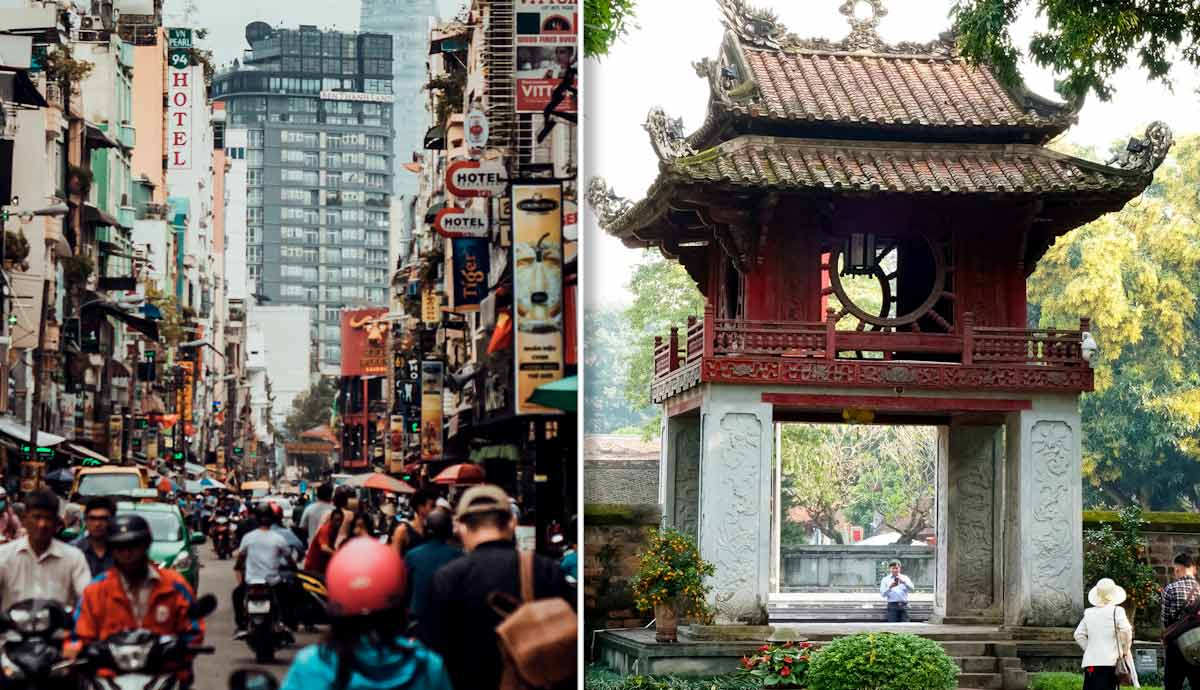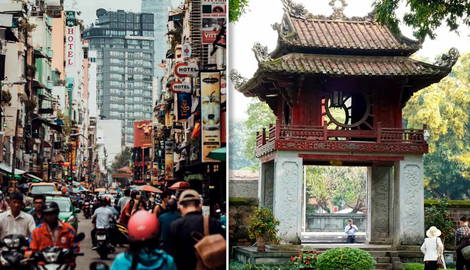
Visit Vietnam today, and you will experience a youthful and vibrant country. Its two major cities are bona fide metropolises that are as exciting as they are sprawling; modern highways dissect its traditional agricultural heartlands, ferrying hi-tech electrical components for export. But, in taking just a minute to look beyond the neon hue of its cities or by diverting from its frantic highways, one will quickly find the quaint colonial villas and millennia-old citadels that symbolize the history of this fascinating Southeast Asian country.
When Is the Best Time To Visit Vietnam?

While sunshine may not be the most important criterion when exploring a country’s history, torrential rain and 40°C heat can ruin the experience. So, to avoid any adverse weather effects (of which Vietnam can experience numerous), here is a helpful guide for when to visit:
Northern Vietnam (Hanoi): The best time to visit Northern Vietnam is during spring (March to April) and autumn (September to November) when the days are warm and sunny. Be aware that winters are cold (December to February), and summers (May to August) are hot and humid.
Central Vietnam (Hue and Hoi An): Central Vietnam has a tropical climate with two distinct seasons: a dry season from January to August and a rainy season from September to December. April to June is ideal as sunny 30°C days are the norm.
Southern Vietnam (Ho Chi Minh City): Due to the region’s location, warm and pleasant temperatures can be found all year round, but bear in mind that summers can be much hotter than the north. The rainy season runs from May to October.
1. The Old Quarter, Hanoi

Colloquially referred to as “The Soul of the Nation,” there is no better place to begin your journey into Vietnam’s captivating past than through the exploration of Hanoi’s Old Quarter. Home to over 1,000 years of migration and commerce, its origins date back to the Ly dynasty (1009-1225) when the establishment of Thang Long (Hanoi) as the new capital under King Ly Thai To began a process of cultural interchange which would last into the 21st century.
Here, take a Xe Om (motorbike taxi) to the quarter’s edge and walk its tree-lined streets amid the metallurgists, silk merchants, and candlemakers who have plied their trade here for centuries. But, when doing so, be sure to look up at the buildings surrounding you and take in the effortless amalgamation of Vietnamese, Chinese, and French architectural influences, which have merged over time to create one of the most atmospheric neighborhoods in the world.
2. The Imperial Citadel, Hanoi

Even for the uninitiated, it won’t take long to realize Vietnam’s history is pockmarked with numerous instances of invasion, colonialism, and resistance, and nowhere better symbolizes this than the Imperial Citadel of Thang Long.
A token of Vietnamese military power since the Ly Dynasty, the citadel’s standing monuments and array of fine artifacts are illustrative of Vietnamese endurance in the face of repeated foreign intrusion. This makes it one of the most important archaeological sites in Southeast Asia.
Its occupation by the People’s Army of Vietnam during the American War as a command post is a fascinating example of defiance, and the preserved bunkers used by celebrated General Tran Hung Dao to defeat American air forces during the Battle of Hanoi superbly portray Vietnam’s resilience. A day is recommended to take in the many historical layers that make up this unique site, which contains relics dating from the 7th to the 20th century.
3. Ho Chi Minh Complex, Hanoi

If Vietnam’s resistance to foreign intervention is to be embodied by one man, it would be former Prime Minister and revolutionary hero Ho Chi Minh. Affectionately referred to as “Uncle Ho,” Ho Chi Minh is considered one of the most important figures in Vietnamese modern history and a powerful symbol of independence. Under his guidance, Vietnam finally threw off the yoke of colonialist rule and saw the country unified in 1976.
Despite asking for a humble burial, his service to his country and the subsequent appreciation felt for him led to the construction of this vast and impressive complex. A peaceful and serene space, the complex is situated within the grounds of the sprawling Ba Dinh Square and contains Ho Chi Minh’s Mausoleum, The Ho Chi Minh Museum (where one can learn about his life and Vietnam’s struggle for independence), and other important sites such as the Presidential Palace. It is a deeply reverent place, so be sure to dress conservatively.
4. The Temple of Literature (Quoc Tu Giam), Hanoi

Celebrated as an example of traditional Vietnamese architecture and a symbol of the country’s enduring value of education, the Temple of Literature is one of Vietnam’s most visited and culturally important locations.
Initially founded in 1070 by emperor Ly Thanh Tong as a site to worship the influential Chinese philosopher Confucius, it would go on to become the country’s first university in 1076. Initially only accepting aristocratic students and educating them in principles of Confucianism, literature, and poetry, the Imperial Academy would gradually adopt a more egalitarian entrance policy that would see the school, over the next 700 years, educate many of Vietnam’s most notable authors and scholars.
As a mark of the Temple’s status as an elite center for learning, in 1442, King Le Thanh Tong began to record the names of the doctors who would pass the school’s infamous Royal exams on 82 turtle-topped stelae. Today, students come from far and wide to rub these turtles for good luck in their own studies.
5. Vietnam Museum of Ethnography, Hanoi

Dedicated to the ethnic diversity that underpins this proud nation, the Vietnam Museum of Ethnography is as much a celebration of the country’s cultural heritage as it is a well-curated exhibition of artifacts and tools that detail Vietnam’s sometimes underappreciated cultural makeup.
Documenting the evolution of important ethnic groups such as the Viet-Muong, Tay-Tai, and Hmong-Yao over the millennia, the museum displays many items, such as the intricate textiles, wooden carvings, and clothing, that have constituted Vietnamese daily life through the years. An open-air exhibition in the Museum’s rear garden also exhibits the variety of architecture, building techniques, and indigenous knowledge that reflects the history and culture of these unique communities.
While primarily focusing on Vietnam, the museum also offers anthropological insights into the rest of Asia as well as Oceania, Africa, and the Americas. It is therefore considered an important research facility for applied anthropology in Southeast Asia.
6. Hue and Surroundings

A picturesque and vibrant city situated on the banks of the Perfume River, much of Hue’s charm can be attributed to the legacy of the Nguyen emperors, who established it as the country’s capital in 1802. Despite being the focus of heavy bombardment during the French and American Wars, the Imperial Citadel’s 10-kilometer walls, moat, and gateway remain intact, and restoration efforts on some of the citadel’s most significant structures are slowly returning it to past glories.
As an incredibly photogenic site, visiting early morning or late afternoon is recommended to avoid the harsh midday light. Hue’s historical relevance also stretches beyond the city limits where, either by organized tour or under one’s own steam, you can take a short motorcycle journey into the surrounding hills and find the spectacular pagodas and tombs built for the citadel’s rulers. Displaying a variety of Vietnamese, European, and Buddhist elements, these grandiose spaces are illustrative of the various influences that shaped imperial rule in 19th-century Vietnam.
7. Hoi An

Containing layers of history that date back over 2,200 years, Hoi An has been the site of a busy seaport since the 2nd Century CE. Originally attracting Arabian, Persian, and Chinese merchants during the reign of the Champa kings, by the 15th century CE, Hoi An would become one of Southeast Asia’s major trading ports due to its economic connections with Asia and the rest of the world.
Over time, the town has come to reflect this fusion of indigenous and foreign cultures that today make it such a unique heritage site. Luckily, because of Vietnam’s economic stagnation in the 19th century, Hoi An did not suffer from the encroaching developmental pressures that have blighted other ancient towns. As a result, many of its famous 17th-century wooden buildings remain intact and functional to the point that the town is still occupied today. It also continues to operate as a trading point and regional center of commerce. To slowly amble its cobbled streets is a time-traveling experience few places on earth can offer.
8. The War Remnants Museum, Ho Chi Minh City

While Vietnam has a proud history of resisting foreign aggression, this poignant yet in places horrific reminder of the depravity human beings can inflict on each other is a blunt portrayal of how war can impact a country’s non-combatants. Constituting nine thematic exhibition spaces over two floors, this well-curated yet harrowing museum aims to not only collect and preserve the legacy of conflict in Vietnam but also serve as an advocate for global peace, friendship, and solidarity among nations today.
While some of the museum’s content is partisan, coverage of events such as the My Lai Massacre by American war photographers like Ron Haeberle makes visiting the War Remnants Museum a compelling experience. Although primarily dealing with the American war, Vietnam’s struggles with China and colonial France are also documented and serve as a brutal reminder of the price many unknowingly pay for the freedom of others.










